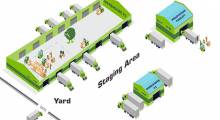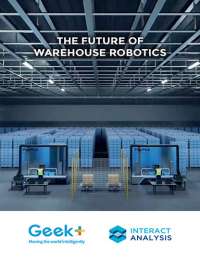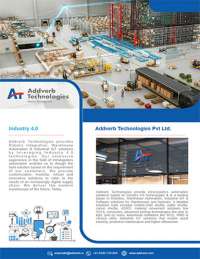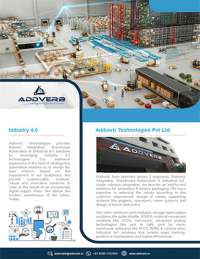OK, I was a skeptic. Boy, was I wrong! I arrived in Atlanta last week with memories of MODEX 2020 dancing in my head. As anyone who was there remembers, attendance was sparse on the busiest of days. Having attended one event this past January with light traffic, and reading accounts of other events that have struggled to get people in the door, I didn’t know what to expect.
Well, MODEX 2022 was perhaps the best trade event I’ve attended in many years. The mood was exuberant, the crowds were there from Monday afternoon through the end of the day on Tuesday, and Wednesday wasn’t half bad.
I don’t know the exact number of exhibitors, but the show approached ProMat levels for sheer scale. And there was a lot to see. Hats off to the staff and leadership at MHI for pulling off a tremendous event at a time when there’s still a lot of uncertainty in the air.
Exhibitors display incremental innovation
So, what was my biggest takeaway from Atlanta? There’s nothing new under the sun. Well, that’s not exactly true – and it’s not meant as a criticism. On the new front, I saw a conveyance system powered by magnets at Beckhoff Automation that I’m still trying to wrap my head around. It’s called the XPlaner, and it’s easier to watch a video than for me to explain what it does (see the bottom of this article).
That said, a lot of what was on display was what Jim Rice, a professor at MIT, calls “sustaining innovation.” This type of innovation represents “the combining and application of a mix of inventions, existing processes, and technologies in a new way to create improvements in cost, quality, cash, and/or service.”
A great example of this recommended to me by several fellow MODEX attendees was the new goods-to-person system from OPEX, which decouples robots from its high-density storage medium. Goods-to-person isn’t new for the industry or OPEX, but the new product is a sustaining innovation based on what the company has already done.
Industry consolidation continues
One notable deal around the show was the acquisition of SDI Systems by Element Logic, a Norwegian firm that is the largest integrator of AutoStore. SDI will serve as Element Logic’s base to enter the North and South American markets.
Examples of partnerships to gain access to new markets included Murata Machinery and AGVE Group, Muratec and Cimcorp, and Addverb Technologies and Numina Group.
And, while not really a consolidation, I remain impressed by the amount of private equity funds that continue to be invested in our space.
Robotics reaches a tipping point
Back in 2015, I invited Tom Galluzzo, the co-founder of IAM Robotics, to write an article for Supply Chain Management Review [Editor's Note: a sibling site to Robotics 24/7] on why roboticists like him were jumping into the materials handling space. The resulting article was titled “Robotics at the Tipping Point.”
The tipping point that Tom was referring to was the entrance of robotics into warehousing and logistics operations when up to that point, robotics was primarily limited to manufacturing. And, with a few piece-picking exceptions, materials handling robots were autonomous mobile robots (AMRs) being used as point solutions, like in robot-to-person fulfillment processes.
That was a huge leap forward, and seven years later, most companies haven’t yet made that leap. But I think we’re at another tipping point that’s being defined in several ways, all of which were on display at MODEX.
Fleets grow from homogenous to heterogenous
Last year, I published an article co-authored by Shekar Natarajan, chief supply chain officer of American Eagle Outfitters, and Parimal Kopardekar, director of the NASA Aeronautics Research Institute (NARI). They made a distinction between what it takes to introduce new technologies into homogenous and heterogenous systems.
They cited the example of adding a new type of aircraft to the national airspace. That’s not a big deal if the new aircraft is a jet, because it will fly at the same speed as the other jets. But, what happens if you try to introduce slow-moving drones or blimps into the same airspace as the jets? Now, everyone has to adjust to whatever is the slowest moving aircraft in the airspace.
Or, as Natarajan and Kopardekar pointed out, in India, it doesn’t matter of you’re driving a high-powered sports car on a congested street. You can only move as fast as the cows that share the road.
I’ll be honest: At the time, the point they were trying to make was over my head. However, if you walked around MODEX, you saw that robotics is moving from point solutions to integrated solutions, sometimes with more than one type of robot. I believe the new tipping point is heterogenous robot fleets in the warehouse. It’s something that Gartner analyst Dwight Klappich has been predicting.
Here’s what that means: The current wave of AMRs began with Kiva, which was segregated from the rest of the warehouse for reasons of safety. It was homogenous. After Amazon bought Kiva, we saw a whole new set of robot-to-goods solutions from companies like Locus Robotics, 6 River Systems, and Fetch Robotics. However, like Kiva, they were homogenous solutions. They did one thing and did it well, but they were “islands of automation.”
At this year's MODEX, we saw vendors such as Addverb Technologies, Geek+, or Mujin showing off their robot portfolios. Or, we saw vendors like RightHand Robotics, HAI Robotics, or Tompkins Robotics demonstrating how all of their different robot types could work together.
For instance, RightHand showed its robot picking not only from a tote to a tote, but also to a tote on someone else’s AMR and onto a Tompkins T-Sort. HAI Robotics demonstrated how its robot could be part of what Klappich describes as a heterogenous setup.
Robot proliferation leads to management questions
The shift from homogenous robot fleets to heterogenous environments raises several questions:
- Who within the organization is going to own the robots, especially if you have an environment were multiple robotic technologies are sharing space with people and other forms of automation? Klappich asks whether it’s time for a chief robotics officer (CRO).
- Can a robotics company do it alone? There are robotics companies with broad portfolios, but more vendors announced partnerships than funding around this MODEX.
- How important are systems integrators? As we move from point solutions to more end-to-end solutions, someone is going to have to integrate the robots. I don’t think that’s going to be the robotics manufacturer. Partnerships between robotics providers and integrators are likely.
- What software system is going to make this happen? Is it a warehouse management system (WMS), a warehouse control system (WCS), a warehouse execution system (WES), a robotics operating system like ROS, or an emerging layer of software like what SVT Robotics has brought to the market? Will it be from the likes of Apple, Google, or Microsoft? I’m betting on the new layer of software, and I think it’s essential to moving robotics forward in our space.
Those are some of the questions I want to see explored at this year’s NextGen Supply Chain Conference in Chicago.
About the Author
Follow Robotics 24/7 on Linkedin
Article topics
Email Sign Up






















